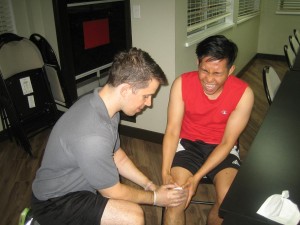Learning first aid could mean the difference between life and death during emergencies. Each circumstance comes with different challenges but in all cases, essential first aid tips come in handy. Practicing the skills learnt will help to improve on them. There is usually little time to search for information during an emergency which is why these tips must be memorized.
How To Manage Breathing Difficulties during first aid
Difficulty in breathing is brought about by numerous situations and medical conditions. The most important thing to do when you want to help such victims is to strike a conversation. Ask them whether or not they require assistance. Here are some more first aid tips:
[youtube url=”https://www.youtube.com/watch?v=TBpK6uI6YP4″ width=”220″]- Assist the person to lie on the floor facing upwards.
- Lift the chin up using your fingers to unblock the throat.
- Check breathing while still holding the victim like this.
- Continue holding the victim that way if breathing is normal. If there are no signs of breathing, start administering CPR.
- Cuts and Bleeding
When dealing with these two types of injuries, several first aid tips will help in managing the situation effectively. For general bleeding, try to stop the blood flow as soon as you can. This can be done by applying pressure to the wound for several minutes until a blood clot forms.
On the other hand, cuts should be washed and disinfected first. Use antiseptic soap and clean water for washing the wound. Pat the area dry with a soft towel. Before you dress the wound, make sure that all foreign particles such as debris are removed from the wound. Sterile, cotton bandages are the best because they facilitate drainage.
How To Manage Arterial Bleeding

For arterial bleeding, which normally involves an artery, seek medical assistance immediately. These cuts are fatal so implement these first aid tips to contain the situation until the paramedics arrive:
- Apply consistent pressure until help arrives. Do not let go because blood may start flowing once again.
- Use a sterile piece of cloth to press the wound. This eliminates the potential risk of infection.
- Bandage the wound. If it is bleeding excessively and consequently soaks the bandage, increase pressure.
- Instead of removing the bandages soaked with blood, opt to using more on top. This will prevent more injuries from occurring while changing bandages.
- Do not clean this type of wound. This is one of the most significant first aid tips for dealing with arterial bleeding.
How To Manage A Bleeding Nose
When dealing with nose bleeding, follow the following steps:
- Pinch nostrils using two fingers to force a blood clot. Hold the nostrils for a period of approx 10 minutes and then let go. If the bleeding still continues, repeat the procedure again.
- Tell the victim to breathe through the mouth when you’re still pinching the nostrils.
- Seek medical assistance if the bleeding persists for more than 20 minutes.
All in all, these first aid tips should not be implemented as a substitute for medical treatment. They’re only meant to contain the situation until the professionals arrive.
